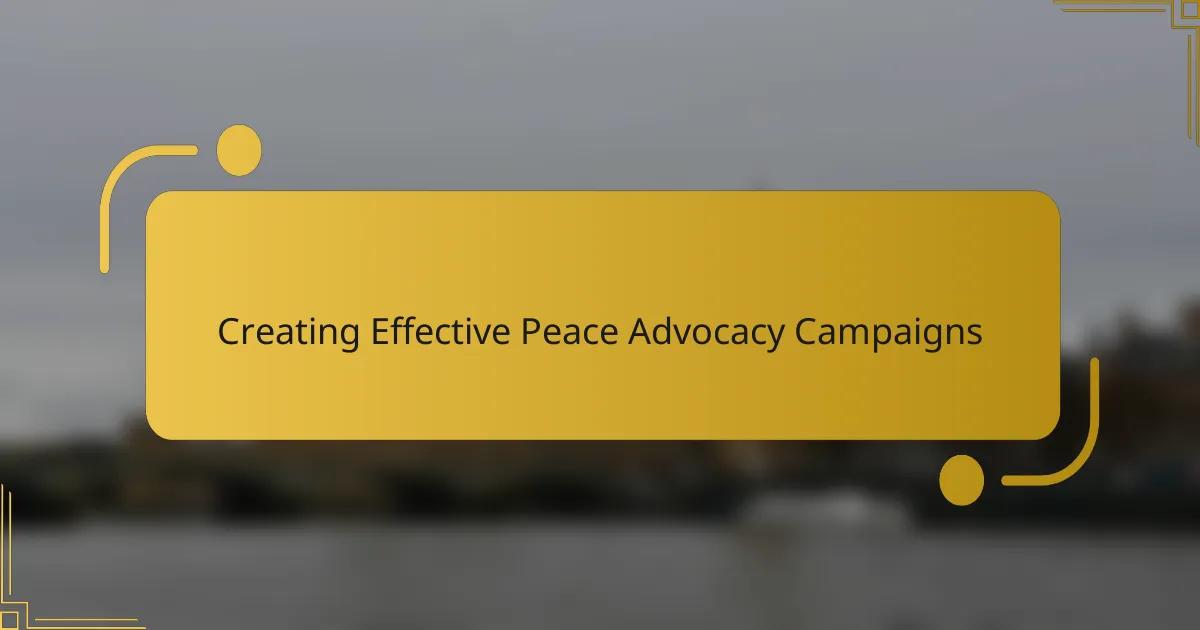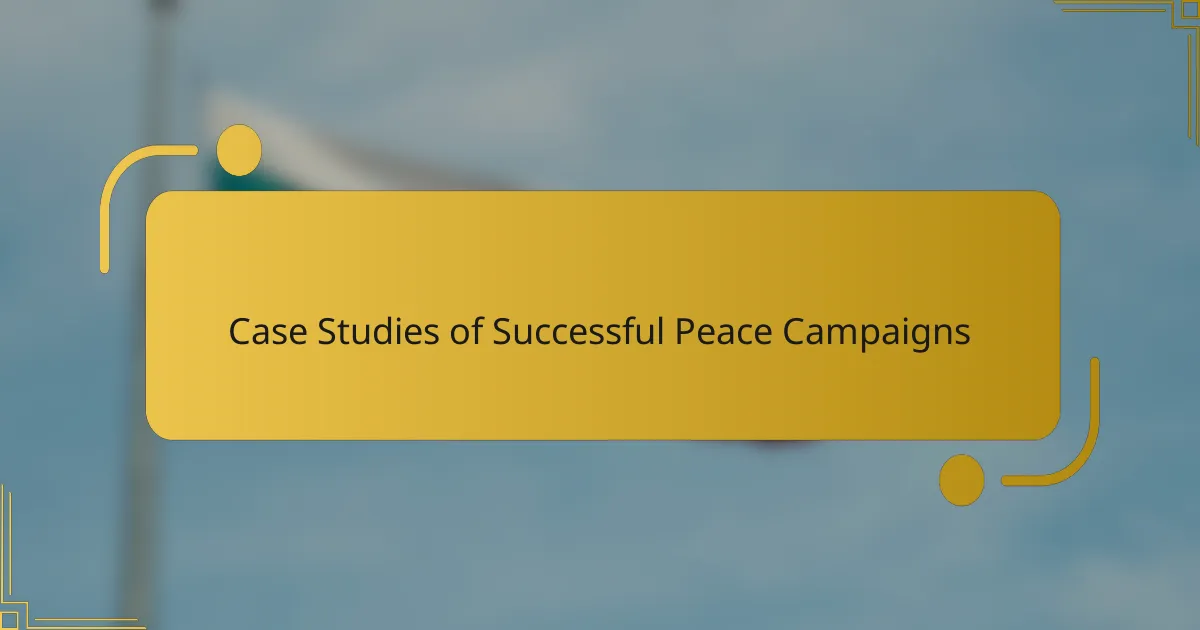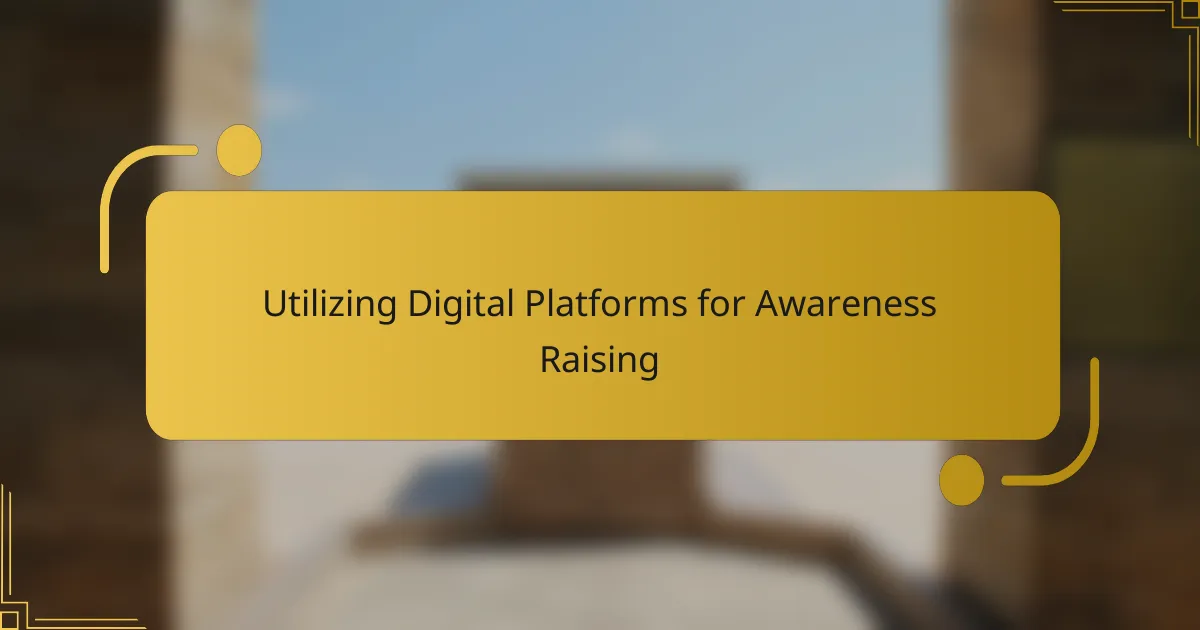Creating effective peace advocacy campaigns requires a deep understanding of the community’s dynamics and the strategic use of local resources. By engaging residents, utilizing digital platforms, and forming partnerships, advocates can amplify their message and promote a culture of peace. Clear messaging, a defined target audience, and effective outreach methods are essential for resonating with stakeholders and driving meaningful action.

How to create impactful peace advocacy campaigns in urban areas
Creating impactful peace advocacy campaigns in urban areas involves understanding the community’s unique dynamics and leveraging local resources effectively. Engaging residents, utilizing digital platforms, and partnering with organizations can amplify your message and foster a culture of peace.
Utilize community engagement strategies
Community engagement is crucial for the success of peace advocacy campaigns. Start by organizing local forums or workshops to discuss peace issues, allowing residents to voice their concerns and ideas. This participatory approach fosters trust and encourages active involvement.
Consider using surveys or polls to gauge community sentiment on peace initiatives. This data can help tailor your campaign to address specific local needs and priorities, ensuring that your message resonates with the audience.
Leverage social media platforms
Social media platforms are powerful tools for spreading awareness and mobilizing support for peace advocacy campaigns. Use platforms like Facebook, Twitter, and Instagram to share stories, updates, and events related to your campaign. Visual content, such as videos and infographics, can enhance engagement and reach a broader audience.
Establish a consistent posting schedule and interact with followers to build a community around your cause. Hashtags related to peace can help increase visibility and connect with like-minded individuals and organizations.
Collaborate with local organizations
Partnering with local organizations can significantly enhance the impact of your peace advocacy campaign. Identify NGOs, community groups, and educational institutions that align with your mission and explore opportunities for collaboration. Joint events, workshops, or campaigns can pool resources and expand your reach.
Additionally, local organizations often have established networks and credibility within the community, which can help legitimize your efforts and attract more participants. Be open to sharing responsibilities and resources to create a more effective partnership.
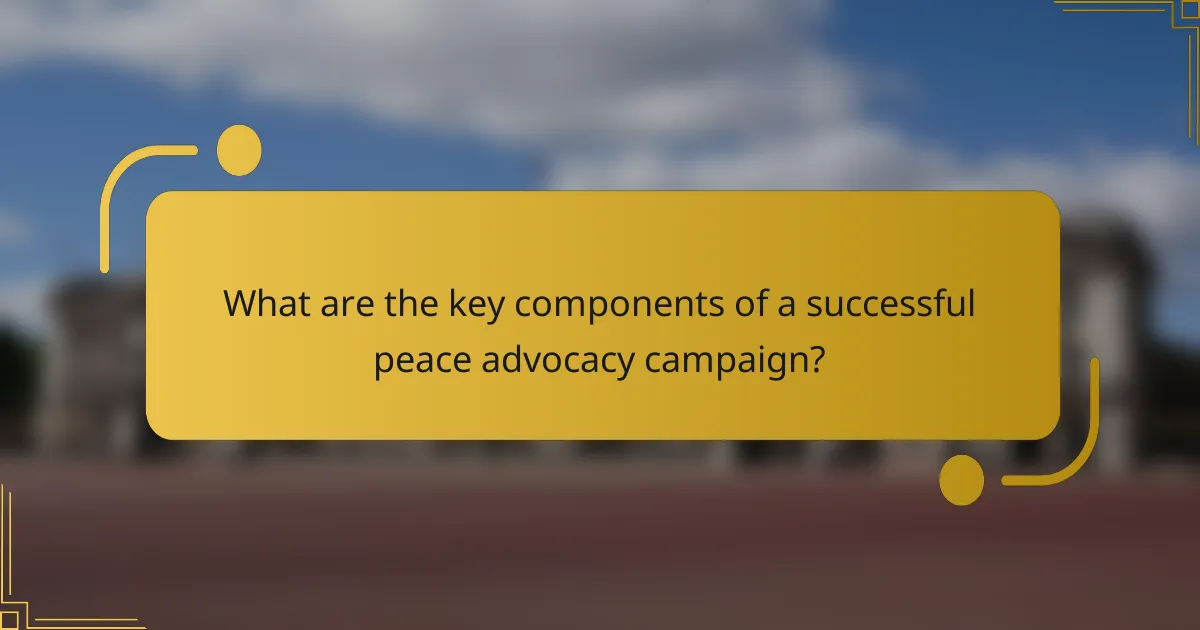
What are the key components of a successful peace advocacy campaign?
A successful peace advocacy campaign consists of clear messaging, a well-defined target audience, and effective outreach methods. These components work together to create a compelling narrative that resonates with stakeholders and drives action towards peace initiatives.
Clear messaging and objectives
Clear messaging is essential for conveying the campaign’s purpose and goals. It should articulate the issues at hand, the desired outcomes, and the actions needed from the audience. Objectives should be specific, measurable, achievable, relevant, and time-bound (SMART) to guide the campaign effectively.
For example, a campaign might aim to reduce violence in a specific region by 20% within two years through community engagement and policy advocacy. This clarity helps unify efforts and motivates supporters.
Target audience identification
Identifying the target audience is crucial for tailoring messages and outreach strategies. Consider demographics such as age, location, and socio-economic status, as well as psychographics like values and beliefs. Understanding these factors allows for more effective communication and engagement.
For instance, if the campaign focuses on youth involvement in peacebuilding, it may target schools, universities, and social media platforms popular among younger demographics. This targeted approach increases the likelihood of resonating with the intended audience.
Effective outreach methods
Effective outreach methods are vital for spreading the campaign’s message and mobilizing support. These can include social media campaigns, community events, partnerships with local organizations, and traditional media outreach. Each method should align with the target audience’s preferences and behaviors.
Utilizing social media platforms like Facebook and Instagram can help reach younger audiences, while community events can foster direct engagement with local residents. A combination of methods often yields the best results, ensuring a wider reach and deeper impact.
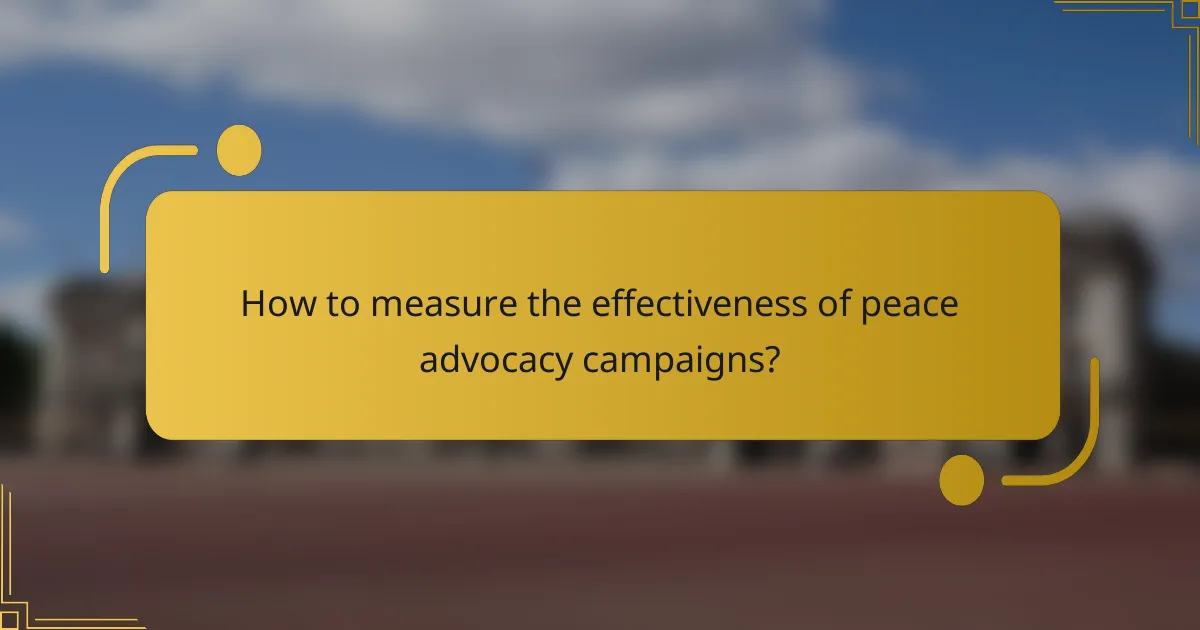
How to measure the effectiveness of peace advocacy campaigns?
Measuring the effectiveness of peace advocacy campaigns involves assessing both quantitative and qualitative outcomes. Key indicators include engagement metrics, participant feedback, and changes in public perception or policy.
Track engagement metrics
Engagement metrics provide insight into how well your peace advocacy campaign resonates with the audience. Key metrics to monitor include social media shares, comments, likes, and website traffic. For instance, a campaign that generates high shares and comments may indicate strong public interest and support.
Consider setting specific goals for these metrics, such as aiming for a 20% increase in social media engagement over a campaign period. Regularly review these metrics to adjust your strategies and enhance outreach efforts.
Conduct surveys and feedback sessions
Surveys and feedback sessions are essential for gathering direct insights from participants and stakeholders. Use online tools to create surveys that assess participants’ perceptions of the campaign’s impact, clarity of messaging, and overall satisfaction. Aim for a response rate of at least 10-15% to ensure reliability.
Feedback sessions can also be conducted in person or virtually, allowing for deeper discussions. This qualitative data can reveal nuanced opinions and suggestions for improvement, helping to refine future campaigns and strategies.
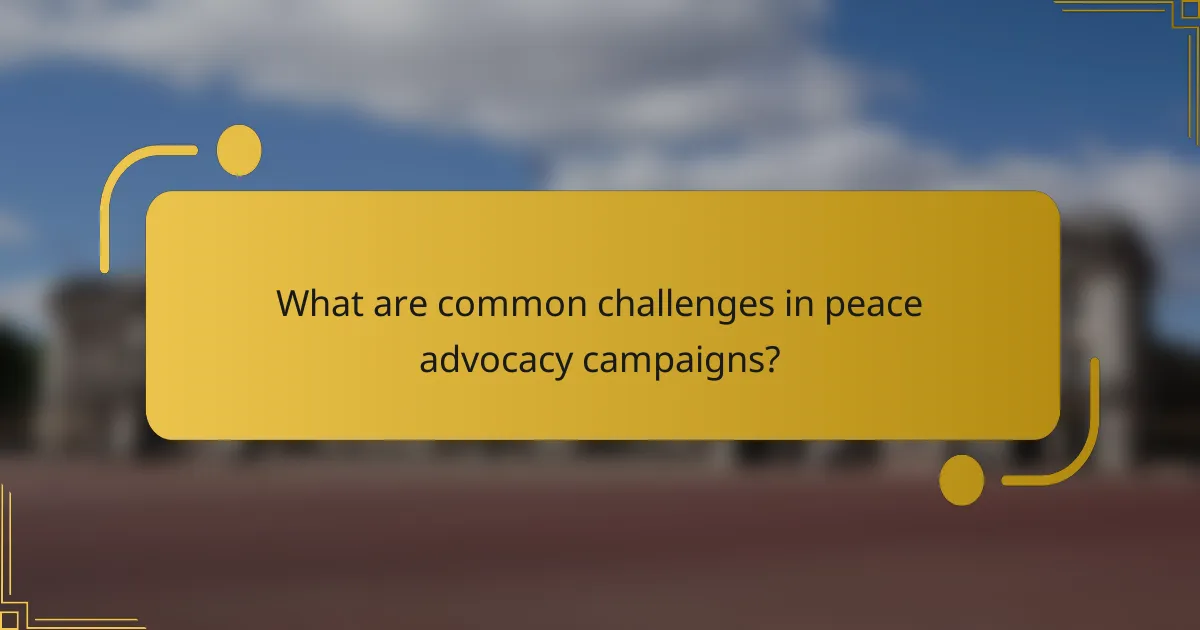
What are common challenges in peace advocacy campaigns?
Peace advocacy campaigns often face several significant challenges that can hinder their effectiveness. Key obstacles include limited funding and resources, resistance from local authorities, and public apathy towards peace-related issues.
Limited funding and resources
Limited funding is a primary challenge for peace advocacy campaigns, as financial constraints can restrict outreach and program implementation. Many organizations rely on donations, grants, or government support, which may not always be sufficient to cover operational costs.
To overcome this, advocates should diversify funding sources by exploring partnerships with businesses, applying for international grants, or engaging in crowdfunding initiatives. Establishing a clear budget and prioritizing essential activities can also help maximize the impact of available resources.
Resistance from local authorities
Resistance from local authorities can significantly impede peace advocacy efforts, as officials may view campaigns as threats to their power or stability. This resistance can manifest in bureaucratic hurdles, restrictions on activities, or even hostility towards advocates.
Building relationships with local leaders and demonstrating the benefits of peace initiatives can help mitigate this resistance. Engaging in dialogue and seeking collaborative approaches can foster a more supportive environment for advocacy efforts.
Public apathy towards issues
Public apathy towards peace issues poses a major challenge, as a disengaged populace may not prioritize or support advocacy campaigns. This lack of interest can stem from a variety of factors, including misinformation, desensitization to violence, or competing social issues.
To combat apathy, campaigns should focus on raising awareness through targeted communication strategies that resonate with the community. Utilizing social media, storytelling, and local events can help engage the public and encourage active participation in peace initiatives.

How to choose the right messaging for peace advocacy?
Choosing the right messaging for peace advocacy involves understanding your audience and crafting messages that resonate with their values and experiences. Effective messaging should be clear, relatable, and inspiring to mobilize support for peace initiatives.
Align with community values
Aligning your messaging with community values is crucial for gaining trust and support. Start by researching the specific beliefs, traditions, and concerns of the community you aim to engage. This can include local customs, historical contexts, and current social issues.
For instance, if advocating in a region where cultural heritage is significant, emphasize messages that highlight peace as a means to preserve and celebrate that heritage. Avoid jargon or concepts that may not resonate with the community’s everyday experiences.
Use storytelling techniques
Storytelling is a powerful tool in peace advocacy, as it humanizes issues and fosters emotional connections. Use real-life stories of individuals affected by conflict or those who have successfully advocated for peace to illustrate your points. This approach can make abstract concepts more tangible.
Consider structuring your stories around a clear narrative arc: introduce a conflict, showcase the impact on individuals or communities, and conclude with a hopeful resolution or call to action. This method can effectively engage your audience and motivate them to participate in advocacy efforts.
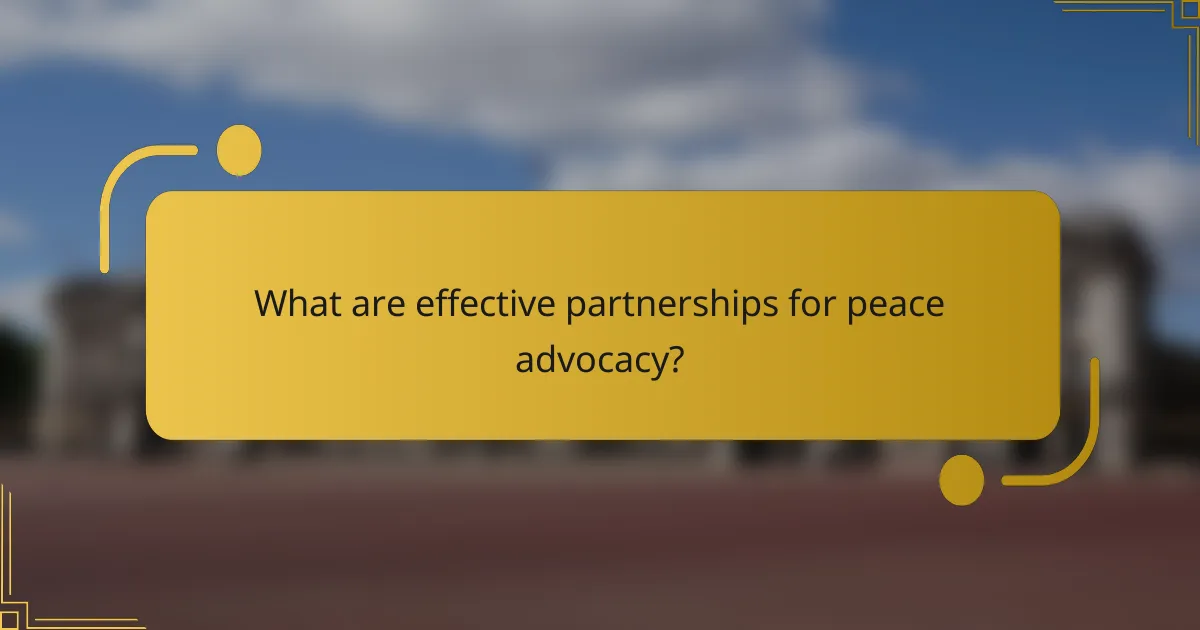
What are effective partnerships for peace advocacy?
Effective partnerships for peace advocacy involve collaboration among diverse stakeholders, including non-governmental organizations, community groups, government agencies, and international bodies. These alliances leverage unique strengths and resources to promote peace initiatives and address conflicts more comprehensively.
Identifying key stakeholders
Identifying key stakeholders is crucial for building effective partnerships in peace advocacy. Stakeholders can include local communities, civil society organizations, government representatives, and international organizations. Engaging a broad spectrum of participants ensures that various perspectives and needs are considered, enhancing the campaign’s relevance and impact.
Building trust and communication
Building trust and maintaining open communication among partners is essential for successful collaboration. Regular meetings, transparent sharing of information, and active listening can foster a positive environment. Establishing clear roles and responsibilities also helps prevent misunderstandings and promotes accountability within the partnership.
Setting common goals
Setting common goals aligns the efforts of all partners towards a unified vision for peace advocacy. These goals should be specific, measurable, achievable, relevant, and time-bound (SMART). For example, partners might aim to reduce violence in a specific area by a certain percentage within a defined timeframe, which helps to maintain focus and motivation.
Leveraging resources and expertise
Leveraging the unique resources and expertise of each partner can significantly enhance the effectiveness of peace advocacy campaigns. For instance, a local organization may have deep community ties, while an international NGO might offer funding and technical expertise. Combining these strengths can lead to more innovative and impactful solutions.
Evaluating and adapting strategies
Regular evaluation of partnership strategies is vital for ongoing success in peace advocacy. Partners should assess the effectiveness of their initiatives, gather feedback, and be willing to adapt their approaches as needed. This iterative process allows for continuous improvement and responsiveness to changing circumstances in the conflict landscape.
